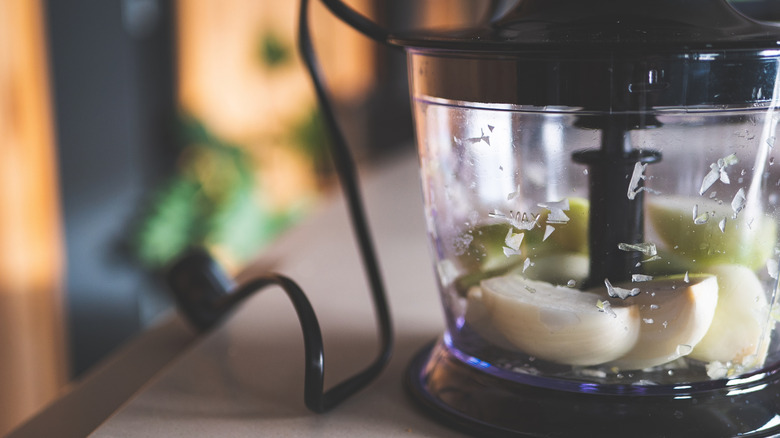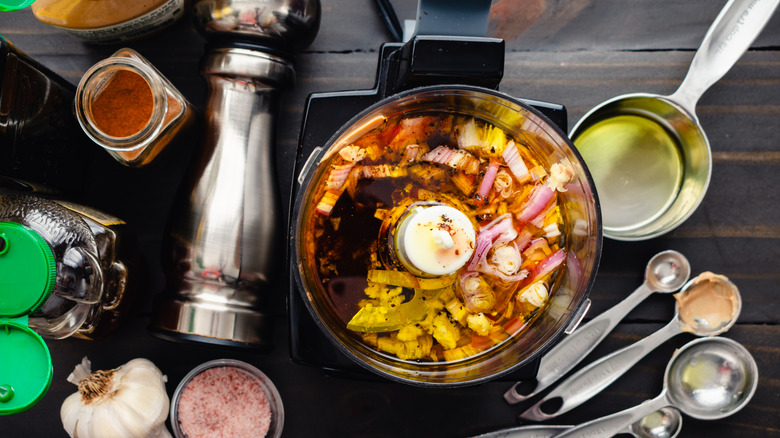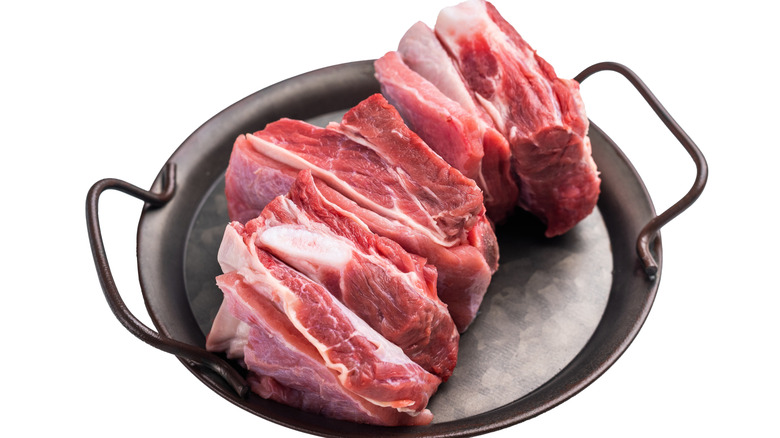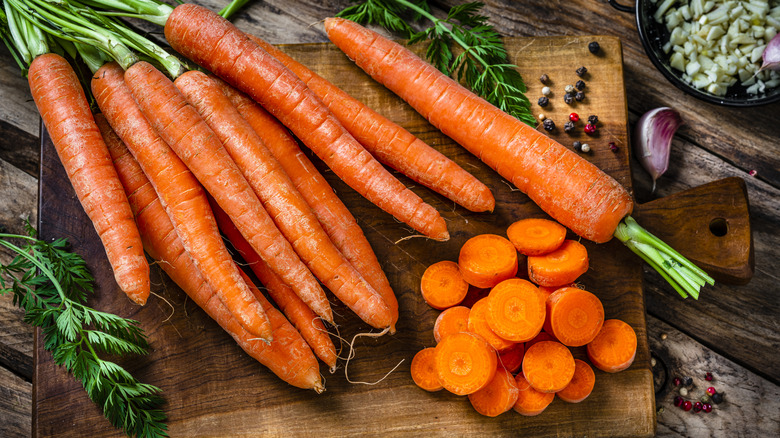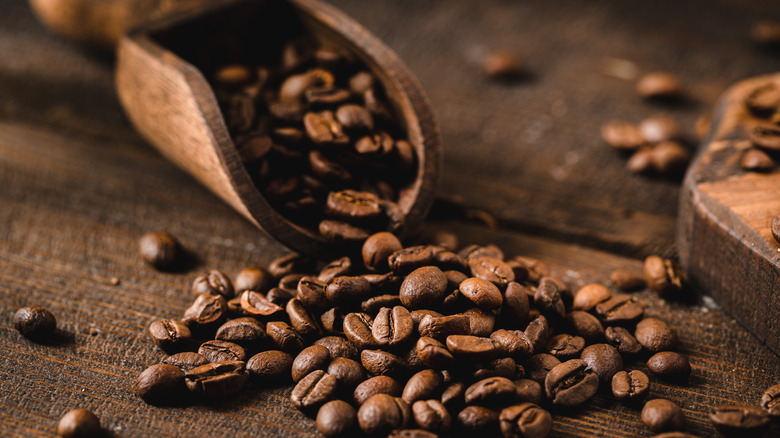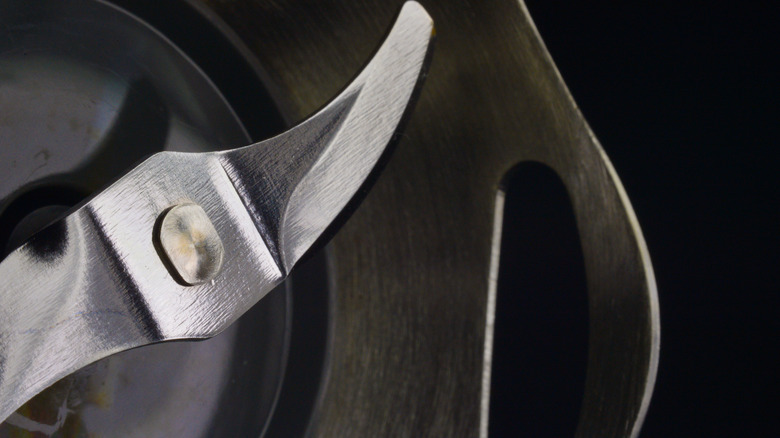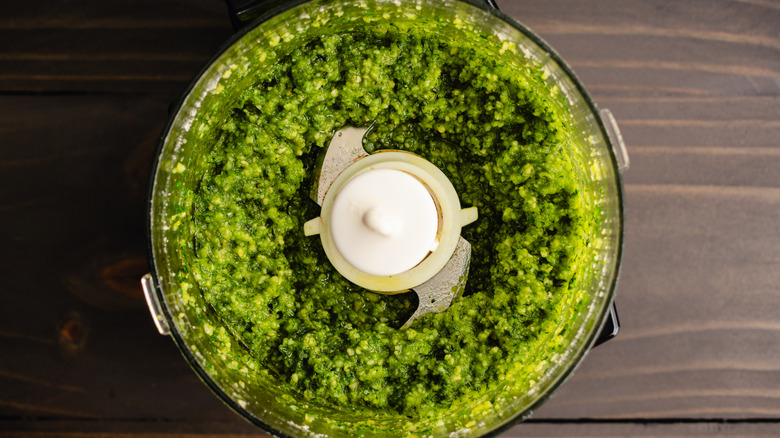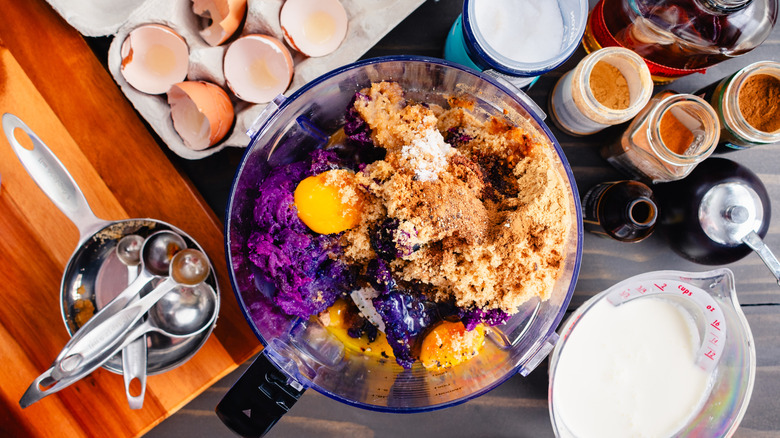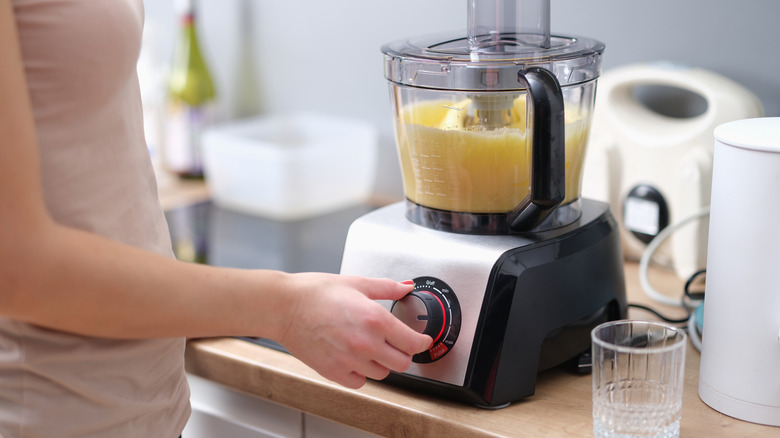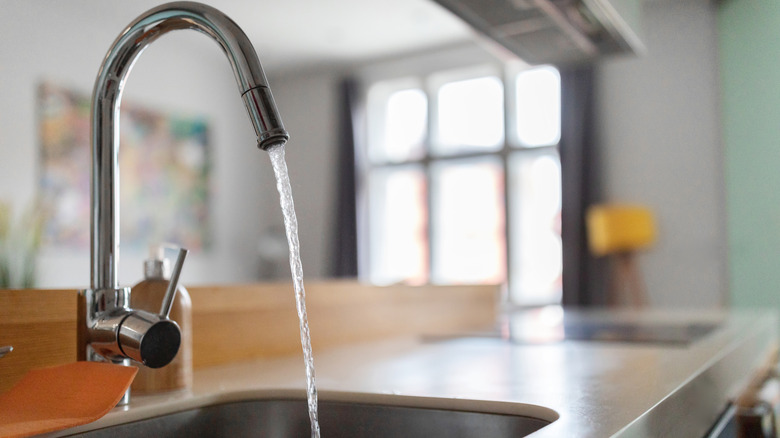The Biggest Mistakes People Make When Using A Food Processor
Once referred to as "revolutionary" by Julia Child, food processors can be an indispensable tool in the kitchen. Designed to chop, slice, shred, knead, and purée ingredients, they can handle the jobs that would otherwise require multiple tools or appliances. Food processors make easy work of tasks that would take much longer by hand, such as chopping carrots or shredding cabbage, saving time and making big-batch cooking projects a breeze. They also simplify kitchen clean-ups by minimizing the number of dirty dishes, cutting boards, and other utensils that normally pile up in the kitchen sink.
The first version of the modern food processor was invented back in 1963. The Robot-Coupe was a sizable machine for professional kitchens that could chop, slice, and purée. A home version of the appliance, the Magimix, entered the market in the early '70s, forever changing the landscape of home cooking by streamlining labor-intensive tasks such as chopping vegetables and kneading dough. Much more advanced than the machines of yesteryear, today's food processors feature an impressive range of interchangeable attachments and discs suited for both basic prep and complex recipes.
While many modern households rely on food processors, a surprising number of home chefs still don't fully understand their capabilities and limitations. With this in mind, here is a roundup of the biggest mistakes made when using a food processor and how to avoid them.
Not locking the lid and securing the attachments
Food processors are powerful and fast. After all, they have been designed to slice through vegetables and meat in seconds. As basic as this may sound, failing to correctly assemble a food processor is one of the most common rookie mistakes out there. It's also one of the most serious, as it not only leads to leaks and spills but it can also damage the machine. In the worst case scenario, food processor components that haven't been locked in place can even lead to injury.
Many modern food processors come with a safety function to ensure that the appliance won't start unless every component is in exactly the right position. If you aren't sure whether your appliance has this safeguard or simply want to err on the side of caution, take your time during the assembly process, double-checking that all the components — including the lid, bowl, and blade — are locked into place. It's also important to have all the components firmly locked before loading the bowl with food, as adding the ingredients first may prevent the blade from fitting correctly.
Using a food processor that's the wrong size
Just like many other kitchen appliances, food processors come in different sizes. Standard household food processors typically range from 6 to 16 cups, although smaller and larger appliances are also available. As such, it pays to think about what kind of ingredients and quantities you are likely to be preparing in the bowl before making an investment. It's also smart to consider whether you have enough kitchen space to accommodate a larger food processor.
As a rule of thumb, food processors that can hold up to 9 cups are ideal for making dips such as creamy hummus or smoky baba ganoush, and chopping nuts to add to your three-ingredient peanut butter cookies. They are also often used for pulverizing herbs to create a fresh, flavorful pesto. Medium food processors with a capacity between 10 and 13 cups are often used for chopping vegetables, puréeing soups and sauces, and shredding hard cheeses. Finally, large food processors are perfect for bulk cooking or kneading large amounts of dough.
While larger food processors can do most jobs handled by their smaller counterparts, they might not be the best option for slicing though small ingredients like nuts and herbs, as explained by one Reddit contributor. "I have a large food processor and the blades are fairly low, but small amounts just don't get mixed around enough [for the appliance] to really be effective," they noted.
Using a food processor for hot or overly hard foods
Despite their powerful motors, food processors have their limitations. Using the machine to chop up overly hard foods could dull or chip the blades or even damage the motor. Hard ingredients like bones, frozen food, or ice are a huge no-no since they can easily snap the appliance's blades. Even hard vegetables like raw sweet potatoes can lead to uneven chopping, blade damage, or motor problems due to excessive strain. So next time you see your processor shake or struggle on the kitchen counter, the best course of action is to stop and rethink your chopping strategy.
Food processors are great for chopping and shredding cold or room-temperature ingredients, but most such appliances are not designed to handle hot food unless the manufacturer explicitly states otherwise. Using a food processor to blend hot foods like soups and sauces can lead to several problems. Firstly, hot liquid can create steam buildup, forcing the appliance's lid to open or leak, which can lead to a mess or even burns. Piping hot food can also melt any plastic components of the processor, damaging the entire appliance. To avoid any issues, it's best to let hot food cool before placing it in the appliance.
Not prepping food before placing it in the bowl
While there is little doubt that food processors make a convenient kitchen companion, they can't handle everything you throw at them. This includes trying to chop, shred, or purée overly large pieces of food. Rather than delivering the results you expect, large ingredients like carrots and potatoes may jam the gadget's blade and strain the motor. At best, the processor will keep running but produce inconsistently-sized pieces. The same goes for unpeeled vegetables and fruit, which can interfere with blade function and uniform chopping.
To prepare fresh produce for processing, wash and peel vegetables and fruit. Next, cut large pieces of fruit, vegetables, or meat into smaller pieces. Cut round fruit and veg like apples and potatoes into halves or quarters. Vegetables like carrots should also be cut down to size so they can easily fit into the feeding chute. In addition, be sure to remove any tough pits from fruits like peaches, cherries, or avocados before popping them in the food processor.
Using a food processor to grind coffee beans
Even though it may be tempting to look at a food processor as a replacement for a coffee grinder, the appliance is not designed to replicate the precision and control necessary to achieve a uniform grind. In fact, even small food processors that only hold a few cups won't create the fine, consistent texture needed to make quality coffee.
While a food processor will do in a pinch, using it to grind coffee beans is likely to leave you with an uneven mix of fine coffee dust and coarse chunks. This can be an issue since coffee grind size affects the flavor of the brew. Since coffee beans are relatively hard, grinding them in a food processor is also likely to damage the appliance's blades over time. If you do have to make do with a food processor to grind beans, it's best to use the appliance's pulse function in short bursts to achieve a more uniform final product and avoid straining the motor.
Before defaulting to a food processor, there are several other ways to prep coffee beans that might not at first seem all that obvious. A spice grinder offers the closest results to a coffee grinder. However, there are plenty of other manual options that can do the trick. One is placing the coffee beans in a Ziplock bag and crushing them with a rolling pin, the head of a hammer, or the flat side of a large knife. Alternatively, you can also use a mortar and pestle or a garlic crasher to break down the beans.
Using the wrong blade or disc for the job
While they have their limitations, food processors are no one trick pony. Most modern food processors come with some interchangeable attachments and discs to make easy work of various ingredients and kitchen tasks. From shredding herbs and grinding meats to beating cake batter, food processors can handle a surprisingly wide range of jobs.
Understanding the functions of food processor attachments can go a long way toward ensuring the results you are after. Blade attachments, which are placed at the bottom of the bowl, come in a range of shapes. One of the most popular — and basic — blades is the S-shaped or Sabatier blade. This general purpose attachment is ideal for dicing, blending, and puréeing ingredients. Other food processor blades include specialty attachments for kneading dough, grinding meat, and even chopping up nuts.
Unlike blade attachments, discs sit at the top of the food processor. These are generally used for more delicate jobs like shredding carrots or grating cheese. Food processor discs include slicing discs, shredding discs, grating discs, and julienne discs. Just as their name suggests, slicing discs are designed for cutting food into even, uniform slices. Shredding and grating discs break down ingredients into fine pieces. Meanwhile, julienne discs slice produce into thin strips.
Overloading the bowl and forgetting to scrape down the sides
There are several reasons you might be tempted to overfill a food processor bowl, particularly if you don't own a large appliance. Perhaps you are cooking for a large group or simply wish to prepare a big batch of dough, soup, or sauce to pop in your freezer. Some home chefs also overfill the food processor to minimize cleaning, since it means they only have to wash one bowl.
The reality is that instead of saving time, overfilling a food processor bowl can actually backfire. Placing too much food in the appliance can hinder blade rotation, leading to unevenly chopped, sliced, or shredded ingredients. It can also put too much pressure on the motor, causing it to overheat. Liquids make overfilling even riskier, since they can splash and create a mess in your kitchen. To prevent accidents, only add liquid until the bowl is around a quarter full.
It's also important to periodically stop the food processor to redistribute any food that's stuck to the walls or the base of the bowl. This ensures that any ingredients that escaped the blades are blended back into the mixture. To keep the food evenly processed, stop the food processor periodically to loosen any stuck ingredients with a plastic spatula.
Failing to make the most of the settings
Given that different ingredients need varying amounts of power and speed to prep, most food processors come with multiple settings. While it may be possible to process all ingredients on a single setting, using the full range of the food processor's functions makes the appliance much more versatile and useful.
Although the settings can differ from one food processor model to another, many feature similar basic functions, such as chop, purée, and adjustable high and low speeds. The chop setting is great for chopping or mincing veggies and meats, while the purée function can be used to turn cooked produce into smooth pastes. Meanwhile, the high and low settings allow users to fine tune the blade speed to handle different kitchen jobs, from delicate slicing to heavy-duty mixing.
Most food processor panels also feature a pulse button. This function can be used to give home chefs more control over the texture of their ingredients by processing them in short bursts. Ideally, the pulse button should be held down for about one second at a time to move the food around the bowl without overprocessing.
Using a food processor when you should be using a blender, and vice versa
Some kitchen jobs can be successfully handled by either a food processor or a blender. Both appliances can be used to purée ingredients for dips, dressings, and sauces. However, it's important to remember that even nut butters, creamy homemade hummus, or flavorful pesto will have different textures depending on whether they have been made in a food processor or a blender. For instance, a pesto made in a blender will be smooth and creamy, whereas one prepped in a food processor will have a coarser texture.
Food processors and blenders have their own strengths and weaknesses, which means that sometimes they shouldn't be used interchangeably. Food processors are unlikely to give you delicate and velvety results. As such, they are better suited to drier recipes that require chopping and shredding than blending ingredients into a smooth consistency. This means that liquid recipes like soups, smoothies, and thin sauces typically come out better in a blender. Similarly, it's best not to use a blender instead of a food processor, as they struggle with denser ingredients.
Letting the food processor overheat
Many modern kitchen appliances, such as blenders, hand mixers, and coffee grinders, are powered by a motor. One of the most powerful and adaptable of these is the food processor, which relies on a motor to chop, slice, and shred. That said, an appliance is only as effective as its motor — this is why it's important to ensure that food processors are not pushed beyond their limits.
Most household food processors come with a motor between 400 to 800 watts, so invest in a more powerful machine if you are planning to put it through challenging tasks like mixing dough for pizza or bread. For recipes that require longer processing time, be sure to take breaks and let the motor cool down. Aside from damaging the appliance, allowing a food processor to overheat can also have a negative effect on the ingredients inside the bowl. These include nut butters and certain doughs, which can lose their quality when subjected to heat. If your food processor continues to overheat, even with small jobs, be sure to have it inspected by a qualified professional.
Neglecting to clean the food processor after use
Just as you wouldn't leave dirty dishes sitting in the sink for days, it's best to thoroughly clean the processor immediately after each use. Even tiny pieces of leftover food stuck to the walls of the bowl or under the blade can lead to bacteria and mold. This, in turn, can contaminate the next dish, potentially resulting in a foodborne illness. Any traces of food can also affect your next cooking project, giving it an off flavor and odor.
Food processors come with multiple parts, including blades, discs, and bowls. Luckily, these are normally easy to separate from the base to simplify cleanups. After the appliance has been disassembled, wipe the base and cord with a damp cloth. Next, wash the bowl, lid, and blades using warm, soapy water. For a quick clean, fill the food processor bowl one-third with water, add a few drops of dish soap, and run it on high for 30 seconds. Be sure to dry all the components with a soft cloth before reassembling the appliance.
While nothing beats hand-washing when it comes to keeping blades sharp, most detachable food processor parts are dish-washer safe. That said, it's best to arrange them on the top rack of the dishwasher and use a gentle cycle that's not overly hot. Never place the food processor's base or power cord in the dishwasher, as this is likely to damage the appliance.
